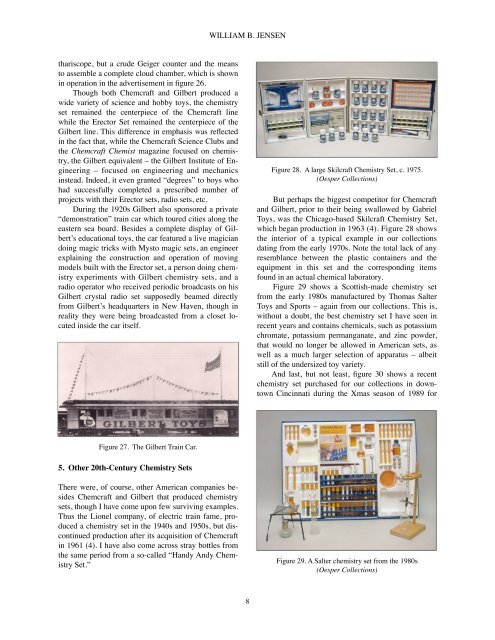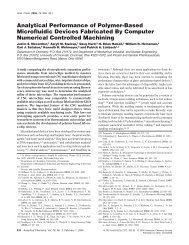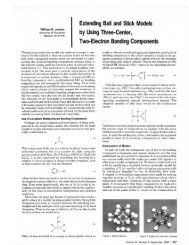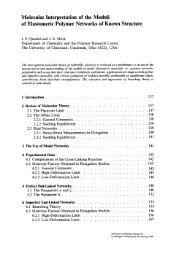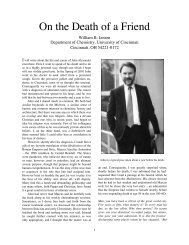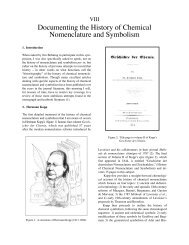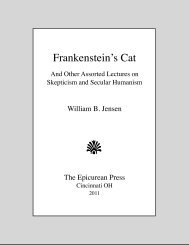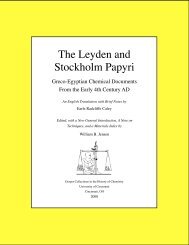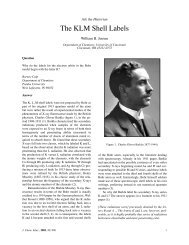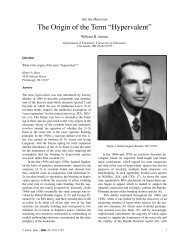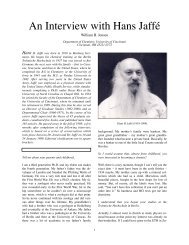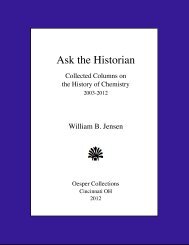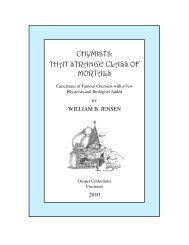03. Chemistry Sets 2'.pdf
03. Chemistry Sets 2'.pdf
03. Chemistry Sets 2'.pdf
Create successful ePaper yourself
Turn your PDF publications into a flip-book with our unique Google optimized e-Paper software.
WILLIAM B. JENSEN<br />
thariscope, but a crude Geiger counter and the means<br />
to assemble a complete cloud chamber, which is shown<br />
in operation in the advertisement in figure 26.<br />
Though both Chemcraft and Gilbert produced a<br />
wide variety of science and hobby toys, the chemistry<br />
set remained the centerpiece of the Chemcraft line<br />
while the Erector Set remained the centerpiece of the<br />
Gilbert line. This difference in emphasis was reflected<br />
in the fact that, while the Chemcraft Science Clubs and<br />
the Chemcraft Chemist magazine focused on chemistry,<br />
the Gilbert equivalent – the Gilbert Institute of Engineering<br />
– focused on engineering and mechanics<br />
instead. Indeed, it even granted “degrees” to boys who<br />
had successfully completed a prescribed number of<br />
projects with their Erector sets, radio sets, etc.<br />
During the 1920s Gilbert also sponsored a private<br />
“demonstration” train car which toured cities along the<br />
eastern sea board. Besides a complete display of Gilbert’s<br />
educational toys, the car featured a live magician<br />
doing magic tricks with Mysto magic sets, an engineer<br />
explaining the construction and operation of moving<br />
models built with the Erector set, a person doing chemistry<br />
experiments with Gilbert chemistry sets, and a<br />
radio operator who received periodic broadcasts on his<br />
Gilbert crystal radio set supposedly beamed directly<br />
from Gilbert’s headquarters in New Haven, though in<br />
reality they were being broadcasted from a closet located<br />
inside the car itself.<br />
Figure 28. A large Skilcraft <strong>Chemistry</strong> Set, c. 1975.<br />
(Oesper Collections)<br />
But perhaps the biggest competitor for Chemcraft<br />
and Gilbert, prior to their being swallowed by Gabriel<br />
Toys, was the Chicago-based Skilcraft <strong>Chemistry</strong> Set,<br />
which began production in 1963 (4). Figure 28 shows<br />
the interior of a typical example in our collections<br />
dating from the early 1970s. Note the total lack of any<br />
resemblance between the plastic containers and the<br />
equipment in this set and the corresponding items<br />
found in an actual chemical laboratory.<br />
Figure 29 shows a Scottish-made chemistry set<br />
from the early 1980s manufactured by Thomas Salter<br />
Toys and Sports – again from our collections. This is,<br />
without a doubt, the best chemistry set I have seen in<br />
recent years and contains chemicals, such as potassium<br />
chromate, potassium permanganate, and zinc powder,<br />
that would no longer be allowed in American sets, as<br />
well as a much larger selection of apparatus – albeit<br />
still of the undersized toy variety.<br />
And last, but not least, figure 30 shows a recent<br />
chemistry set purchased for our collections in downtown<br />
Cincinnati during the Xmas season of 1989 for<br />
Figure 27. The Gilbert Train Car.<br />
5. Other 20th-Century <strong>Chemistry</strong> <strong>Sets</strong><br />
There were, of course, other American companies besides<br />
Chemcraft and Gilbert that produced chemistry<br />
sets, though I have come upon few surviving examples.<br />
Thus the Lionel company, of electric train fame, produced<br />
a chemistry set in the 1940s and 1950s, but discontinued<br />
production after its acquisition of Chemcraft<br />
in 1961 (4). I have also come across stray bottles from<br />
the same period from a so-called “Handy Andy <strong>Chemistry</strong><br />
Set.”<br />
Figure 29. A Salter chemistry set from the 1980s<br />
(Oesper Collections)<br />
8


